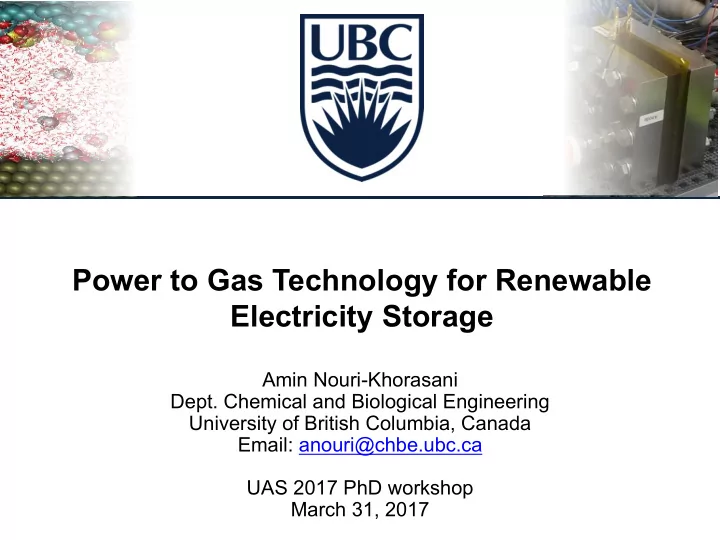

Power to Gas Technology for Renewable Electricity Storage Amin Nouri-Khorasani Dept. Chemical and Biological Engineering University of British Columbia, Canada Email: anouri@chbe.ubc.ca UAS 2017 PhD workshop March 31, 2017
University of British Columbia 2
Renewable energies in the 21 st century Renewable energy challenge: Intermittency Opportunity: Developing energy storage technologies! ”We are heading into an era of energy abundance” Prof. Eicke Weber, Director of Fraunhofer ISE (2014) 3 M. Cembalest, “A brave new world”, J.P. Morgan Annual energy paper, Oct. 2015
Outline • Introduction to the cycle of renewable hydrogen • Power to gas energy storage • PEM water electrolysis • Bubble removal in a PEM electrolysis cell • Policies for energy storage • Policy suggestions for P2G incentivizing • Summary 4
Cycle of renewable hydrogen Picture source: hydrogen.energy.gov/pdfs/htac_apr16_10_pivovar.pdf 5
Power to gas (P2G) technology • Robust framework for the electricity grid management. • Multiple energy, chemical, and electrochemical pathways for hydrogen after production. Picture source: www.powertogas.info 6
Part 1 Modeling oxygen bubble removal from water electrolyzers . 7
PEM water electrolysis technology • Reactions: – Anode: 2H # O l → 𝑃 # + 4𝐼 , + 4𝑓 . – Cathode: 4𝐼 , aq + 2𝑓 . → 2𝐼 # 123456 𝑃 # + 𝟑𝑰 𝟑 𝒉 – Total: 2H # O l 8
O 2 bubbles in PEMWE cells Oxygen evolution at PEMWE anode: 2H # O l → 𝑷 𝟑 𝒉 + 4𝐼 , + 4𝑓 . • • O 2 bubbles obscure the reaction sites, and increase the cell overpotential (decrease the electrolysis efficiency). 2.6 Cell polarization 2.4 Cathode activation overpotential η mass trans Anode activation overpotential 2.2 η act, cat Ohmic (membrane) overpotential Reversible cell voltage 2 Cell voltage [V] η act, an 1.8 1.6 η mem 1.4 1.2 Erev 1 0 1 2 3 4 5 Current density [A/cm ² ] Kang, Z. et al. Energy Environ. Sci. (2016). doi:10.1039/C6EE02368A Tabu-Ojong, E., Nouri-Khorasani, A. et al. (Submitted to Intl. J. Hydrogen Energy) 9
Electrolysis cell modeling • Growth and stability simulation of O 2 bubbles in identical straight cylindrical porous transport layer. Nouri-Khorasani, A. et al. (Submitted to Intl. J. Hydrogen Energy) 10
Part 2 Energy policies to incentivize Power to gas 11
Energy storage policy background • Traditional perspective on energy storage: energy security – Dependency on foreign oil, imported natural gas • 95% of energy storage capacity in Europe is pumped hydro storage. – Different policies across member states. • New challenges: – Grid share of “volatile” primary renewable energies. – Possible “phase out” policy for coal in Germany and around the world. Source: “Energy storage: Which market designs and trgulatory incentives are required?” S. Urgate, Report to European Parliament, IP/A/ITRE/2014-05 12
What is the value of energy storage? • Curtailment costs depend mainly on the renewables penetration, grid interconnection, and energy storage strategies available. • ”Reliability” value. • Power to gas offers a scalable solution to our Megawatt energy challenge! Source: Toronto Star, February 2013 13
Demonstration project examples • Thüga group demonstration project in Frankfurt (2013) • UC Irvine campus microgrid P2G project (2016) 14
Policies to support energy storage Current policy: • (EC 2014/C 200/01): generators receiving state aid should at least adhere to standard balancing requirements. • Current policy cost : 0.2-1 c/kWh for the wind energy sector. Suggested policy change : • Incentives for the research on energy storage technology. • Natural gas (NG) sales regulation : Amending NG sales contracts to include acceptance of a concentration <15% of hydrogen mix with the distributed NG. – Cleaner burn for the NG mix – Advancing e-mobility targets 15
Conclusion • Power to gas technology provides energy storage opportunities up to megawatts. • Mathematical modeling research aimed at improving mass transport in the electrolysis cells by efficient bubble removal. Hydrophilicity and pressure are the most important conditions for optimal electrolysis operation. • In the current century with an energy abundance and sustainability paradigm, policies aiming at energy storage should look beyond energy security. • Feed-in stability regulations, and energy storage incentives can lead to developing a more balanced energy grid, cleaner natural gas mix, and smaller energy curtailment costs. 16
Recommend
More recommend